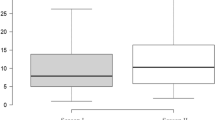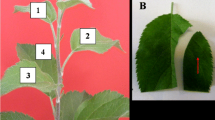Abstract
The amounts of accumulated callose and phenol compounds in sprouts of two winter wheat cultivars under inoculation with pathogenic fungus Pseudocercosporella herpotrichoides, the causing agent of wheat eyespot, were determined. Considerable differences were demonstrated in the constitutional and induced accumulation of phytoimmunity substances by the sprouts of the Myronivska 808 and Renan cultivars, which cause specific features of their resistance to pathogenic microorganisms.






Similar content being viewed by others
REFERENCES
Hatfield, J.L. and Prueger, J.H., Temperature extremes: effect on plant growth and development, Weather Climate Extremes, 2015, vol. 10, pp. 4–10. https://doi.org/10.1016/j.wace.2015.08.001
Tasmina, T., Khan, A.R., Karim, A., Akter, N., and Islam, R., Physiological changes of wheat varieties under water deficit condition, Bangladesh Agron. J., 2016, vol. 2, no. 19, pp. 105–114. https://doi.org/10.3329/bjsr.v29i2.32333
Titov, A., Kasina, N., and Talanova, V., Plant Resistance to Cadmium, Petrozavodsk: Proceedings of the Karelian Scientific Center RAS, 2012.
Savary, S., Ficke, A., Aubertot, J.N., and Hollier, C.A., Crop losses due to diseases and their implications for global food production losses and food security, Food Security, 2012, vol. 4, no. 4, pp. 519–537. https://doi.org/10.1007/s12571-012-0200-5
Nedukha, O.M., Callose: localization, functions, and synthesis in plant cells, Cytol. Genet., 2015, vol. 49, no. 1, pp. 49–57. https://doi.org/10.3103/S009545-2715010090
Zhu, J.K., Abiotic stress signaling and responses in plants, Cell, 2016, vol. 2, no. 167, pp. 313–324. https://doi.org/10.1016/J.CELL.2016.08.029
Ponce, De., Leon, I., and Montesano, M., Activation of defense mechanisms against pathogens in mosses and flowering plants, Int. J. Mol. Sci., 2013, vol. 2, no. 14, pp. 3178–3200. https://doi.org/10.3390/ijms14023178
Wei, L., Advances and prospects in wheat eyespot research: contribution from genetics and molecular tools, J. Phytopathol., 2011, vol. 7, no. 8, pp. 235–243.
McIntosh, R.A., Close genetic linkage of genes conferring adult-plant resistance to leaf rust and stripe rust in wheat, Plant Pathol., 1992, vol. 41, no. 5, pp. 523–527.
McIntosh, R.A. and Brown, G.N., Anticipatory breeding for resistance to rust diseases in wheat, Annu. Rev. Phytopathol., 1997, vol. 35, pp. 311–326.
Sibikeev, S.N. and Druzhin, A.E., Prebreeding research of near-isogenic lines of spring bread wheat with a combination of translocations from Agropyron elongatum (Host.) P.B. and Aegilops ventricosa Tausch, Vavilov J. Genet. Breed., 2015, vol. 19, no. 3, pp. 310–315. https://doi.org/10.18699/VJ15.040
Dumalasová, V., Palicová, J., Hanzalová, A., Bížová, I., and Leišová-Svobodová, L., Eyespot resistance gene Pch1 and methods of study of its effectiveness in wheat cultivars, Czech. J. Genet. Plant Breed., 2015, vol. 4, no. 5, pp. 166–173. https://doi.org/10.17221/157/2015-CJGPB
Cook, D.E., Mesarich, C.H., and Thomma, B.P., Understanding plant immunity as a surveillance system to detect invasion, Annu. Rev. Phytopathol., 2015, no. 53, pp. 541–563. https://doi.org/10.1146/annurev-phyto-080614-120114
Ray, R.V., Crook, M., Jenkinson, P., and Edwards, S., Effect of eyespot caused by Oculimacula yallundae and O. acuformis, assessed visually and by competitive PCR, on stem strength associated with lodging resistance and yield of winter wheat, J. Exp. Bot., 2006, vol. 10, no. 57, pp. 2249–2257. ISSN: 0022-0957.
Blein, M., Levrel, A., Gautier, V., Muranty, H., and Barloy, D., The specific effects of the pch1 resistance gene on the development of Oculimacula yallundae, the causing agent of wheat eyespot, Options Méditerranéennes, 2015, no. 81, pp. 159–162.
Hanzalová, A., Dumalasová, V., Tsumíková, T., and Bartoš, P., Rust resistance of the French wheat cultivar Renan, Czech J. Genet. Plant Breed., 2007, vol. 2, no. 43, pp. 53–60. https://doi.org/10.17221/1912-CJGPB
Boboshko, O.P., Panyuta, O.O., Artemenko, O.Y., Emelyanov, V.I., and Taran, N.Y., Time-course of pathogen induced accumulation of callose as mechanical protective barrier in wheat seedlings, Cytol. Genet., 2017, vol. 51, no. 1, pp. 26–31. https://doi.org/10.3103/S0095-452717010029
Smirnova, O.G. and Kochetov, A.V., Plant cell wall and mechanisms of resistance to pathogens, Russ. J. Genet. Appl. Res., 2016, vol. 6, no. 5, pp. 622–31. https://doi.org/10.18699/VJ15.109
Doughari, J.H., An overview of plant immunity, J. Plant Pathol. Microbiol., 2015, vol. 6, no. 322, pp. 1–11. https://doi.org/10.4172/2157-7471.1000321
Malinovsky, F.G., Fangel, J.U., and Willats, W.G., The role of the cell wall in plant immunity, Front. Plant Sci., 2014, vol. 5, no. 178, pp. 1–12. https://doi.org/10.3389/fpls.2014.00178
Underwood, W., The plant cell wall: a dynamic barrier against pathogen invasion, Front. Plant Sci., 2012, vol. 3, no. 85. https://doi.org/10.3389/fpls.2012.00085
Cle, C., Hill, L.M., Niggeweg, R., Martin, C.R., Guisez, Y., Prinsen, E., and Jansen, M.A.K., Modulation of chlorogenic acid biosynthesis in Solanum lycopersicum; consequences for phenolic accumulation and UV-tolerance, Phytochemistry, 2008, vol. 69, no. 11, pp. 2149–56.
Prigogine, I. and Kondepudi, D., Modern Thermodynamics. From Heat Engines to Dissipative Structures, Moscow: Mir, 2002.
McLusky, S.R., Bennett, M.H., Beale, M.H., Lewis, M.J., Gaskin, P., and Mansfield, J.W., Cell wall alterations and localized accumulation of feruloyl-30-methoxytyramine in onion epidermis at sites of attempted penetration by Botrytis allii are associated with actin polarisation, peroxidase activity and suppression of flavonoid biosynthesis, Plant J., 1999, vol. 17, no. 5, pp. 523–534.
Zeyen, R.J., Carver, T.L.W., and Lyngkjr, M.F., Epidermal cell papillae, in The Powdery Mildews: A Comprehensive Treatise, MN, USA: APS Press, 2002.
Ferrazzano, G.F., Amato, I., Ingenito, A., Natale, DeA., and Pollio, A., Anti-carcinogenic effects of polyphenols from plant stimulant beverages (cocoa, coffee, tea), Fitoterapia, 2009, vol. 80, no. 20, pp. 255–262. https://doi.org/10.1016/j.fitote.2009.04.006
Emelyanov, V.I., Kravchuk, J.N., Poliakovskiy, S.O., and Dmitriev, O.P., Callose deposition in the processing of the cells of tomato (Lycopersicon esculentum L.) biotic elicitors, Cytol. Genet., 2008, vol. 42, no. 2, pp. 90–95. https://doi.org/10.3103/S0095452708020047
Venzhik, Y., Tiotov, A., and Talanova, V., Response of wheat plants to the combined impact of low temperature and cadmium, Proc. Karelian Sci. Center RAS, 2017, no. 12, pp. 108–117. https://doi.org/10.17076/eb662
Karou, D., Dicko, M.H., Simpore, J., and Traore, A.S., Antioxidant and antibacterial activities of polyphenols from ethnomedicinal plants of Burkina Faso, Afr. J. Biotechnol., 2005, no. 4, pp. 823–828.
Gupta, S.K. and Tripathi, S.C., Fungitoxic activity of Solanum torvum against Fusarium sacchari, Plant Protect. Sci., 2011, vol. 47, no. 3, pp. 83–91.
Plotnikova, L.Y., Cytological, molecular and genetic bases of plant species immunity to fungal pathogens, Mycol. Phytopathol., 2008, vol. 42, no. 5, pp. 393–410.
Udalova, Zh.V. and Zinovieva, S.V., Induction of plant resistance to nematodes sedentary biogenic elicitors, Russ. J. Parasitol., 2016, vol. 38, no. 4, pp. 575–582.
Chowdhury, J., Henderson, M., Schweizer, P., Burton, R.A., Fincher, G.B., and Little, A.C., Diferential accumulation of callose, arabinoxylan and cellulose in nonpenetrated versus penetrated papillae on leaves of barley infected with Blumeria graminis f. sp. Hordei, New Phytologist, 2014, vol. 3, no. 204, pp. 650–60. PMID: 25138067
Zipfel, C., Pattern-recognition receptors in plant innate immunity, Curr. Opin. Immunol., 2008, no. 20, pp. 10–16. https://doi.org/10.1016/j.coi.2007.11.003
Newman, M.A., Dow, J.M., Molinaro, A., and Parrilli, M., Priming, induction and modulation of plant defense responses by bacteria lipopolysaccharides, J. Endotoxin Res., 2007, no. 13, pp. 69–84.
Nicaise, V., Roux, M., and Zipfel, C., Recent advances in PAMP-triggered immunity against bacteria: pattern recognition receptors watch over and raise the alarm, Plant Physiol., 2009, no. 150, pp. 1638–1647.
Miedes, E., Vanholme, R., Boerjan, W., and Molina, A., The role of the secondary cell wall in plant resistance to pathogens, Front. Plant Sci., 2014, no. 5, pp. 358–364. https://doi.org/10.3389/fpls.2014.00358
Ozgonen, H., Yardimci, N., and Kilic, H.C., Induction of phenolic compounds and pathogenesis related proteins by mycorrhizal fungal inoculations against Phytophthora capsici Leonian in pepper, Pak. J. Biol. Sci., 2009, vol. 17, no. 12, pp. 1181–1187. https://doi.org/10.3923/pjbs.2009.1181.1187
Plotnikova, L.Y., Cytological, molecular and genetic bases of plant species immunity to fungal pathogens, Mycol. Phytopathol., 2008, vol. 42, no. 5, pp. 393–410.
Glansdorff, P. and Prigogine, I., Thermodynamics Theory of Structure, Stability and Fluctuations, London: Wiley-Interscience, 1971. https://doi.org/10.1119/1.1987158
Bhuiyan, N.H., Selvaraj, G., Wei, Y., and King, J., Role of lignification in plant defense, Plant Signal. Behav., 2009, vol. 2, no. 4, pp. 158–190. https://doi.org/10.4161/psb.4.2.7688
Wei, L., Advances and prospects in wheat eyespot research: contribution from genetics and molecular tools, J. Phytopathol., 2011, vol. 159, nos. 7–8, pp. 457–470.
Panyuta, O.O., Belava, V.N., and Taran, N.Y., UA Patent no. 389960 A01N 1/04, 2014.
Kauss, H., Jeblick, W., and Domard, A., The degrees of polymerization and N-acetylation of chitosan determine its ability to elicit callose formation in suspension cells and protoplasts of Catharanthus roseus, Planta, 1989, vol. 178, no. 3, pp. 385–392. PMID: .24212905
Kim, K.-H., Tsao, R., Yang, R., and Cui, S.W., Phenolic acid profiles and antioxidant activities of wheat bran extracts and the effect of hydrolysis conditions, Food Chem., 2006, vol. 95, no. 3, pp. 466–473. https://doi.org/10.1016/j.foodchem.2005.01.032
Emelyanov, V., Polyakovsky, S., and Dmitriev, A., Trigger range of concentrations of cytosolic calcium in induction of defense reactions in tomato cells (Lycopersicon esculentum L.), Rep. NAS Ukr., 2008, no. 6, pp. 153–157. http://dspace.nbuv.gov.ua/handle/ 123456789/4949.
Prigogine, I., From Being to Becoming, Moscow: Science, 1985.
Sanders, R.A. and Hiatt, W., Tomato transgene structure and silencing, Nat. Biotechnol., 2005, vol. 3, no. 23, pp. 287–289. PMID .15765076
Barrangou, R., The bacterial origins of the CRISPR genome-editing revolution, Hum. Gene Ther., 2015, vol. 26, no. 7, pp. 413–424.
Funding
This study did not receive any specific grants from financial institutions in the public, commercial, or noncommercial sectors.
Author information
Authors and Affiliations
Corresponding authors
Ethics declarations
The authors declare that they have no conflict of interest. This article does not contain any studies involving animals or human participants performed by any of the authors.
Additional information
Translated by K. Lazarev
About this article
Cite this article
Boboshko, O., Emelyanov, V., Panyuta, O. et al. Constitutional and Induced Accumulation of Callose and Phenol Compounds as Elements of Systemic Resistance in Winter Wheat Sprouts. Cytol. Genet. 53, 375–383 (2019). https://doi.org/10.3103/S0095452719050049
Received:
Revised:
Accepted:
Published:
Issue Date:
DOI: https://doi.org/10.3103/S0095452719050049




